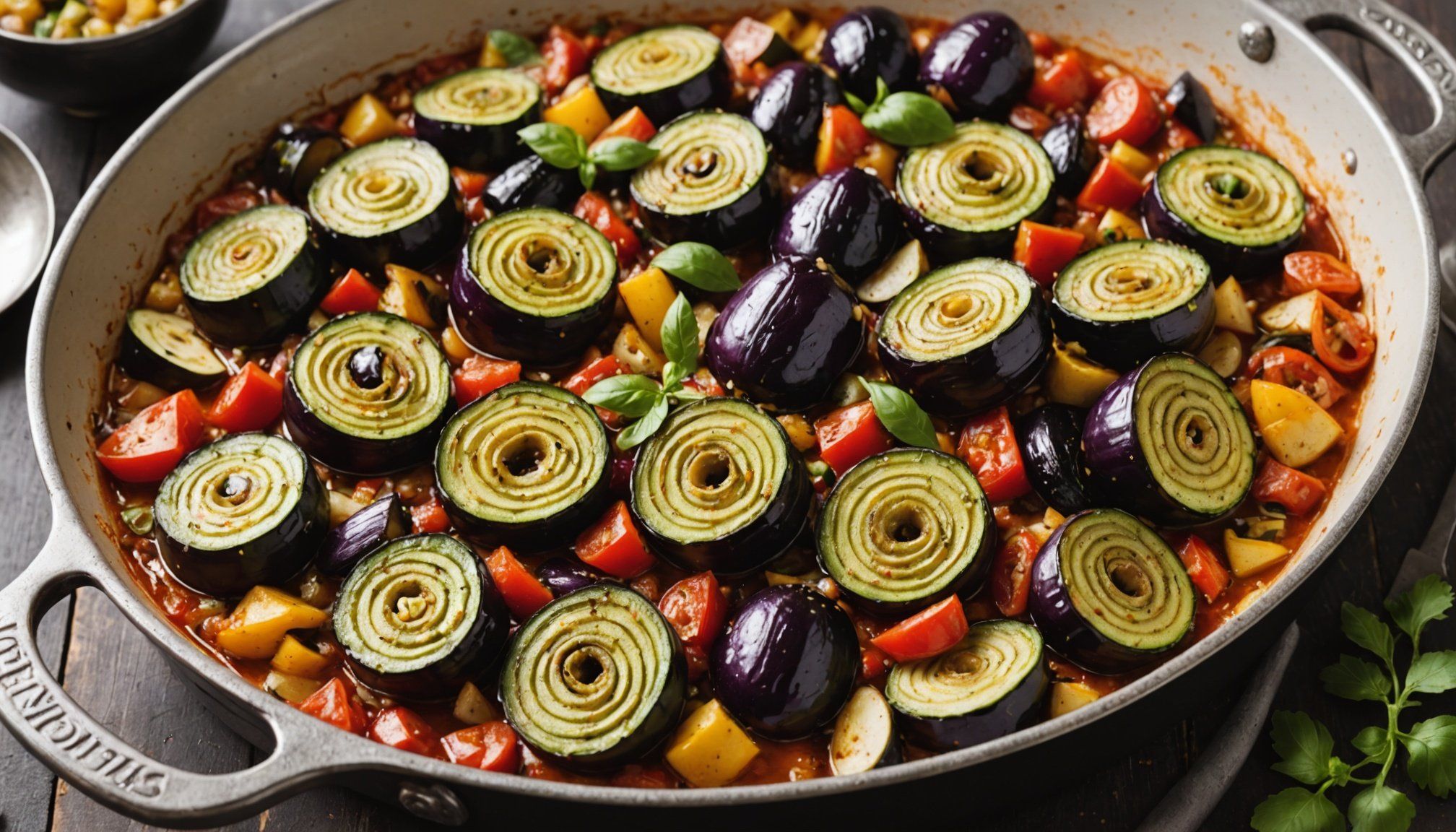Overview of Provençal Ratatouille
Provençal cuisine is a culinary celebration that embodies the flavours and traditions of the southern region of France. At the heart of this cuisine is ratatouille, a dish that traces its history back to the peasant kitchens of Provence. Originally, this vegetable medley was made from whatever fresh ingredients were available, offering a glimpse into the resourcefulness and appreciation for local produce in French culinary traditions.
The key ingredients in ratatouille include eggplant and zucchini, two staples that provide the dish with its distinctive texture and taste. These vegetables, in combination with tomatoes, bell peppers, onions, and herbs, are sautéed to create a harmonious blend of flavours. Eggplant adds a richness to the dish, absorbing the juices and spices, while zucchini offers a subtle sweetness and a firmer bite.
Additional reading : Unlock the Ultimate Sweet & Tangy English Rhubarb Crumble: A Masterclass Recipe Guide
Culturally, ratatouille plays a significant role in French cuisine as a representation of regional pride and traditional cooking techniques. It’s more than just a dish; it’s a testament to the Provençal way of life, celebrating the bounty of the land and the simplicity of rustic cooking. This iconic dish continues to inspire chefs and home cooks alike, maintaining its revered status in both history and modern gastronomy.
Essential Ingredients for Ratatouille
Selecting the right ratatouille ingredients is vital to capturing the authentic flavours of this Provençal classic. Traditional vegetables include eggplants, zucchinis, tomatoes, bell peppers, and onions. Each component plays its part in creating a harmonious blend.
Also to discover : Unlock the Ultimate Sweet & Tangy English Rhubarb Crumble: A Masterclass Recipe Guide
To begin, focus on finding fresh produce. Opt for eggplants and zucchinis that are firm to the touch and have a glossy skin. These qualities ensure the vegetables are ripe and ready, offering maximum taste. When it comes to tomatoes, choose those with a balanced acidity and sweetness to complement the dish’s overall flavour profile.
Beyond just the basic vegetable selection, seasonal freshness is key. Provençals believe that using what’s in season not only enhances taste but also pays homage to their culinary heritage. A dish made with out-of-season produce may lack the vibrant tastes and aromas that define genuine ratatouille. Local markets often provide the best chance of finding these seasonal treasures.
In summary, the essence of ratatouille lies in its ingredients. By paying close attention to the selection and quality of the produce, one can recreate the rustic elegance of this beloved Provençal dish.
Preparing Your Ingredients
Preparing the ingredients is an essential step in crafting a delicious ratatouille. To begin, focus on ingredient preparation by thoroughly washing and peeling your vegetables. This ensures cleanliness and enhances flavour absorption. Next, chopping techniques are critical, especially for eggplant and zucchini. Aim to dice them into even pieces to promote uniform cooking, which is vital for maintaining texture.
For cutting techniques, slice the eggplant into thick cubes. This step allows them to absorb deeply the spices and juices during cooking. The zucchini should be cut into rounds or half-moons, preserving its subtle sweetness and providing a delightful bite. These methods help optimize flavour and are instrumental in a harmonious vegetable medley.
Cooking prep goes beyond cutting. After chopping, consider pre-salting the eggplants. This process helps in reducing bitterness and further enriches the dish’s flavour profile. Additionally, allow your vegetables to rest post-chopping to drain excess moisture, enhancing the ratatouille’s consistency.
In summary, the meticulous preparation of ingredients, with a focus on washing, peeling, and precise chopping, is crucial to achieving the desired texture and taste in ratatouille. This dedication to prep work is at the heart of this Provençal classic.
Cooking Techniques for Ratatouille
Crafting a delectable ratatouille involves mastering a few essential cooking methods. Sautéing is a critical technique in which vegetables are quickly fried in a small amount of oil. This method unlocks their natural flavours. Begin by sautéing bell peppers and onions over medium heat to soften them.
Once the initial sautéing is complete, consider simmering the mixture. This technique entails slow-cooking vegetables at a lower temperature, which allows all ingredients to amalgamate smoothly. Simmering ensures the dish develops a rich, cohesive flavour.
In addition, braising techniques offer distinct advantages. By partially submerging and cooking vegetables in a broth or sauce, you create a depth of flavour. Remember to adjust the heat to maintain a gentle, steady cooking pace, promoting even cooking and preventing burning.
The method of layering vegetables is employed for a well-integrated taste. Start with heartier vegetables like eggplant, followed by softer ones such as zucchini. This sequence prevents overcooking while achieving the perfect texture.
By focusing on these techniques, you’ll ensure ratatouille boasts both taste and texture. Employing careful heat control and strategizing your cooking sequence results in a dish that’s both memorable and delightful.
Flavor Enhancements and Pairings
Enhancing the flavor profile of ratatouille involves selecting the right herbs and spices. Essential choices include thyme and basil, both key to infusing the dish with a traditional Provençal essence. They complement the natural flavors of the vegetables, enhancing the sweetness of zucchinis and the earthiness of eggplant. Balancing the acidity and sweetness in ratatouille is a subtle art, achieved by seasoning with salt and a dash of balsamic vinegar, if desired.
Pairing ratatouille with other foods can elevate the dining experience. Consider serving it alongside proteins like grilled chicken or fish, enhancing both the dish and main course with a harmonious blend of flavors. Alternatively, pair it with a grain like quinoa or couscous for a complete vegetarian meal.
For those aiming to optimize enjoyment, think about the acidity balance—use lemon zest or a splash of vinegar to achieve this. Such creativity ensures a well-rounded flavor profile, making each bite a celebration of Provençal cuisine. These techniques and pairings not only maintain the dish’s authenticity but also provide a satisfying culinary adventure.
Variations of Ratatouille
Ratatouille offers a diverse array of variations that reflect the rich tapestry of regional adaptations. Across Provence and beyond, local preferences and available ingredients have led to unique interpretations, transforming this classic dish to suit different palates.
One popular variation involves a creative twist with ingredient substitutions. For example, some cooks replace traditional eggplant with mushrooms for a heartier taste, while others add squash or sweet potatoes for a touch of sweetness. These substitutions not only offer fresh flavors but also cater to dietary restrictions. Vegan and gluten-free adaptations are easily achievable by excluding animal-based products and ensuring gluten-free natural ingredients.
Moreover, the cooking style can greatly influence flavor and texture. While the classic method involves sautéing, some regions prefer to oven-bake the ingredients for a roasted flavor, enhancing the natural sweetness of the vegetables. The choice of herbs and spices can also vary, with some opting for rosemary or oregano instead of basil.
Incorporating these creative touches allows ratatouille to evolve, maintaining its status as both a traditional dish and a canvas for culinary experimentation. These adaptations ensure that ratatouille remains a modern favorite while respecting its rich heritage.
Nutritional Information and Health Benefits
Ratatouille is celebrated for its impressive nutritional value, with each ingredient offering a bounty of health benefits. At its core, this dish is a vegetarian staple loaded with vitamins, minerals, and antioxidants representative of Provençal cuisine.
Eggplants are rich in fibre and antioxidants, particularly nasunin, which promotes cellular health by protecting against oxidative stress. Zucchinis, another key component, are low in calories yet high in vital nutrients, such as vitamin C and potassium, which support heart health and immune function.
Incorporating ratatouille into your diet can contribute to a more balanced eating regimen. The dish’s composition of fresh vegetables aids in digestion, assists in managing weight due to its low-caloric nature, and boosts overall wellness. Pulses of herbs, like basil and thyme, further enhance the health quotient by adding anti-inflammatory and immune-boosting properties.
As a low-calorie, high-nutrient meal, ratatouille aligns with healthy eating patterns proposed by dietary guidelines worldwide. Its dense nutritional profile makes it an excellent choice for individuals seeking to amplify their intake of plant-based foods without sacrificing flavour or satisfaction in their meals.
Serving Suggestions and Presentation
Presenting Provençal ratatouille can elevate your dining experience, offering a feast for both the eyes and taste buds. To start, consider creative plating ideas that highlight the vibrant hues of the vegetables. Use a shallow bowl or coloured plate to accentuate the dish’s natural brightness. Layer the ratatouille attractively, showcasing the variety of textures and colours.
When it comes to pairing, select side dishes that complement the rich flavours of ratatouille. Serving tips suggest options like crusty French bread or a light salad. These additions can balance the hearty nature of ratatouille, providing a well-rounded meal. Alternatively, pair with a glass of Provençal rosé for an authentic touch.
Incorporate cultural practices from French dining to enhance the experience further. Traditionally, ratatouille is served informally, embracing its rustic roots. Yet, you can elevate its presentation for special occasions. Amidst a setting adorned with simple, natural elements, the dish takes centre stage.
By focusing on thoughtful presentation and complementary pairings, you not only honour the cuisine’s heritage but also create a delightful and unforgettable culinary experience.
Frequently Asked Questions
Unravel the mysteries of crafting a perfect ratatouille. Here, we’ve compiled frequently asked questions to ensure your dish reaches its Provençal potential.
Why is my ratatouille soggy? This common issue often stems from improper heat control or overcrowding ingredients. Ensure your pan is hot enough before sautéing and avoid stuffing too many vegetables at once. This allows for sufficient evaporation of excess moisture, maintaining the dish’s ideal texture.
How can I store leftovers? Place any remaining ratatouille in an airtight container and refrigerate it for up to three days. For a longer duration, consider freezing it. When reheating, use a low simmer on the stove to retain flavours without breaking down the vegetables’ structure.
Can I prepare ratatouille in advance? Absolutely! This dish often tastes better the next day as the ingredients’ flavours meld. If possible, make it a day ahead and store it properly to enhance its rich taste.
What’s the best way to serve ratatouille? Present it alongside crusty bread or over a bed of rice for a complete meal. These FAQs aim to refine your technique and amplify your dining experience.



